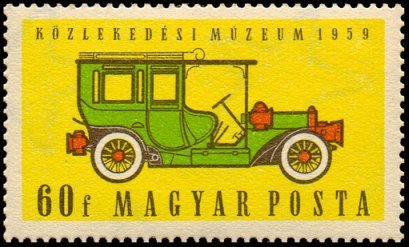Stamp: Csonka automobile (Hungary 1959)
Csonka automobile (Hungary 1959)
26 May (Hungary ) within release Transport Museum, Budapest goes into circulation Stamp Csonka automobile face value 60 Hungarian fillér
| Stamp Csonka automobile in catalogues | |
|---|---|
| Michel: | Mi:HU 1587A |
| Stamp Number: | Sn:HU 1227 |
Stamp is horizontal format.
Also in the issue Transport Museum, Budapest:
- Mini Sheet - Mail coach in front of building face value 4*2.50;
- Stamp - Early steam locomotive face value 20;
- Stamp - Diesel train face value 30;
- Stamp - Early railway sign face value 40;
- Stamp - Csonka automobile face value 60;
- Stamp - Icarus bus face value 1;
- Stamp - First lake Balaton paddlesteamer "Kisfaludy" face value 2;
- Stamp - Mail coach in front of building face value 2.50;
- Stamp - Early plane face value 3;
- Stamp - Mail Coach in front of Building face value 2.50;
Stamp Csonka automobile it reflects the thematic directions:
A vehicle (from Latin: vehiculum) is a mobile machine that transports people or cargo. Typical vehicles include wagons, bicycles, motor vehicles (motorcycles, trucks, buses), railed vehicles (trains, trams), watercraft (ships, boats), aircraft and spacecraft. Land vehicles are classified broadly by what is used to apply steering and drive forces against the ground: wheeled, tracked, railed or skied. ISO 3833-1977 is the standard, also internationally used in legislation, for road vehicles types, terms and definitions.
A car is a wheeled, self-powered motor vehicle used for transportation and a product of the automotive industry. Most definitions of the term specify that cars are designed to run primarily on roads, to have seating for one to eight people, to typically have four wheels with tyres, and to be constructed principally for the transport of people rather than goods. The year 1886 is regarded as the birth year of the modern car. In that year, German inventor Karl Benz built the Benz Patent-Motorwagen. Cars did not become widely available until the early 20th century. One of the first cars that was accessible to the masses was the 1908 Model T, an American car manufactured by the Ford Motor Company. Cars were rapidly adopted in the United States of America, where they replaced animal-drawn carriages and carts, but took much longer to be accepted in Western Europe and other parts of the world.
A museum (/mjuːˈziːəm/ mew-ZEE-əm) is an institution dedicated to displaying and/or preserving culturally or scientifically significant objects. Many museums have exhibitions of these objects on public display, and some have private collections that are used by researchers and specialists. Compared to a library, a museum hosts a much wider range of objects and usually focus around a specific theme such as the arts, science, natural history, local history, and other topics. Public museums that host exhibitions and interactive demonstrations are often considered to be tourist attractions, and many museums attract large numbers of visitors from outside their host country, with the most visited museums in the world regularly attracting millions of visitors annually.
Transport or transportation is the movement of people, animals and goods from one location to another. Modes of transport include air, rail, road, water, cable, pipeline and space. The field can be divided into infrastructure, vehicles and operations. Transport is important because it enables trade between people, which is essential for the development of civilizations.




